GeneSafe Complete test
The GeneSafe Complete test is a prenatal non-invasive screening test that provides information about 29 different single-gene pathologies in the fetus, which can cause 44 different new-onset and 5 genetic diseases inherited from parents, which are not often detected by ultrasound and which often manifest only in the late period of pregnancy or in the first years of life. The occurrence of monogenic diseases is not influenced by the mother's age; however, these conditions tend to be more common in fetuses with older biological fathers.
How does the GeneSafe Complete test work?
The GeneSafe Complete test is done from a maternal blood sample that contains both maternal and fetal DNA (genetic material). The fetal DNA to be tested comes from the placenta. The GeneSafe Complete test detects fetal DNA from the mother's blood sample and uses it to assess whether or not the fetus has the genetic disease the test is searching for. The sex of the fetus cannot be identified with this test. Completing the GeneSafe Complete test also requires an analysis of the oral mucosa of the child's biological father.
The GeneSafe Complete test is a non-invasive prenatal screening test that is completely safe for you and your baby. To perform the test, a blood sample is taken from your arm and a father's oral mucosa DNA sample is taken with a swab, which are sent with an express courier to the Eurofins Genoma Laboratory in Rome, Italy. The Eurofins Genoma Laboratory has 20 years of experience in prenatal genetic testing. Every year, more than 200,000 genetic tests are performed in this laboratory.
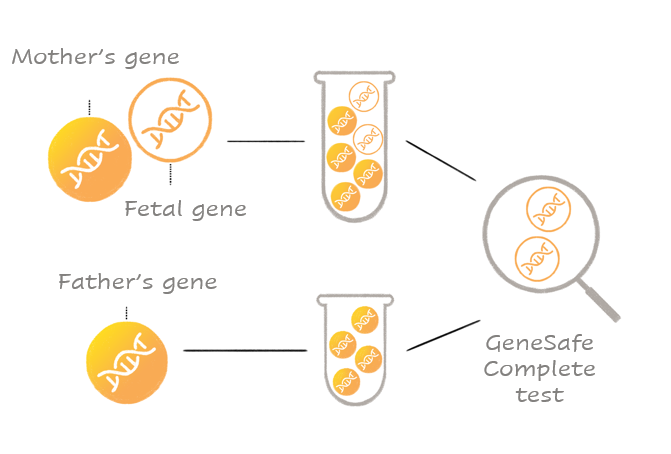
What will the GeneSafe Complete test tell me?
The PrenatalSafe Complete test searches for monogenic diseases that are inherited according to Mendel's laws. Monogenic diseases are caused by a mutation in one or both genes (alleles) of a gene pair.
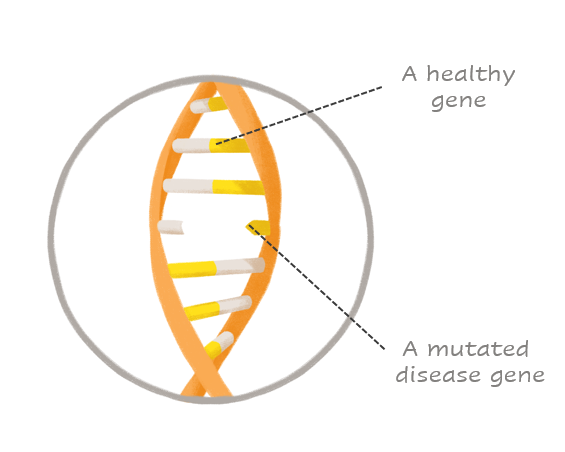
Generally, such diseases are only caused by a gene mutation and the environment plays no role in the occurrence thereof. Such inheritable diseases are also called Mendelian diseases as they are consistent with the laws of inheritance discovered by the monk Gregor Mendel. These diseases are almost exclusively rare, which means that they occur in less than one fetus out of two thousand.
Since the GeneSafe Complete test searches for 49 monogenic diseases, the combined incidence of those diseases is one fetus in six hundred (1 : 600) fetuses. This is higher than the incidence of Down syndrome.
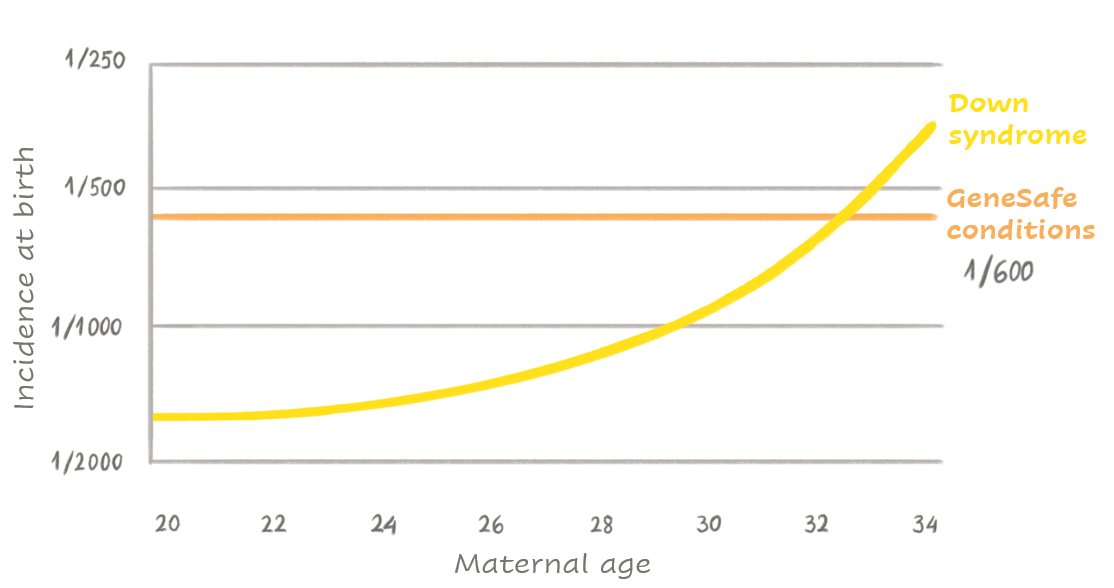
The occurrence of monogenic disorders is based on either the principle of dominant (prevailing) or recessive (hidden) inheritance. If the gene causing the disease is in the autosome (chromosomes 1−22), it is considered autosomal inheritance and the disease occurs in a similar manner regardless of gender.
The GeneSafe Complete test is a screening test that is able to detect autosomal recessive diseases inherited from the parents as well as novel diseases that occur after the fertilization of the egg (de novo diseases).
The CeneSafe Complete test searches for new mutations (de novo mutations). In this case, the disease gene has not been inherited by either of the parents but has emerged during the formation of the sperm cell or the egg cell (for example, Rett or Noonan syndrome). New mutations are especially prominent in autosomal dominant diseases as these are apparent right away – healthy parents surprisingly give birth to an ill child who will, in turn, pass the disease on to their future children in 50% of cases.
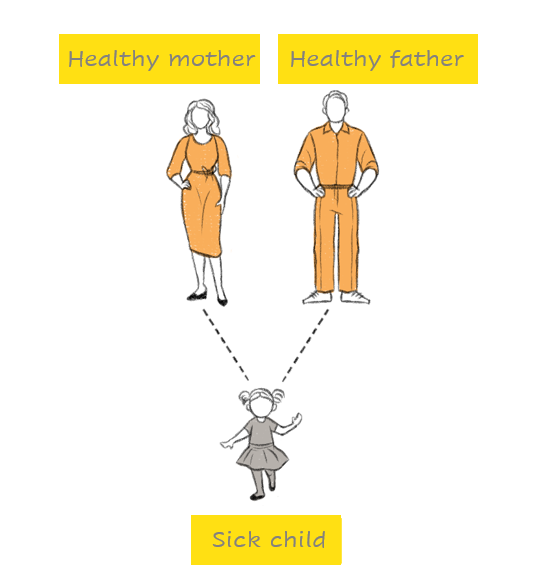
An autosomal recessive mutation is inherited from both parents (for example, cystic fibrosis, congenital sensorineural deafness). This means that in order for a genetic disease to develop, the child must have a change in both genes of a gene pair. When a child inherits one altered gene and one normal gene from their parent, the normal gene usually compensates for the altered gene in most cases. Thus, the child is the bearer of the mutation, but they don't have the disease itself. If both parents are carriers of the same gene mutation, they pass either the normal or the altered gene on to their child. The selection is random. Therefore, every child whose both parents carry the same altered gene, has a 1 in 4 (25%) risk of getting a mutated gene from both parents and therefore developing an inherited disease.
Since the genes causing autosomal recessive diseases are located in the autosomal chromosomes (chromosomes 1–22), the disease manifests similarly in both boys and girls. Such risks occur with every pregnancy.
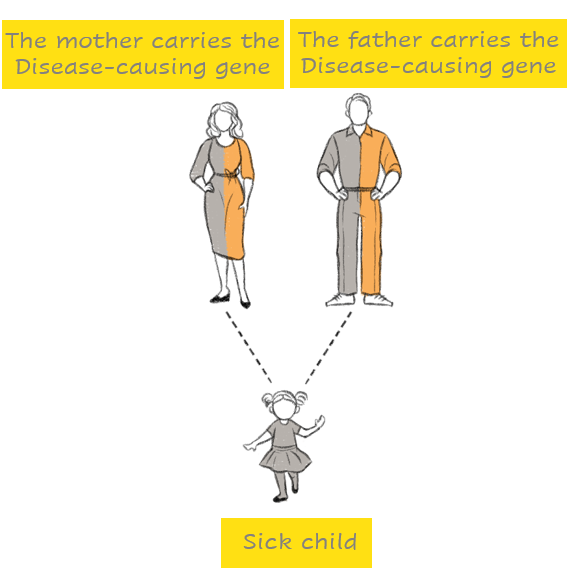
How reliable is the GeneSafe test?
This screening test is able to detect more than 99% of the tested 29 genetic mutations . The need to repeat the test due to an unclear result is less than 1%.
What are the alternatives to the GeneSafe test?
The GeneSafe test is a screening for the detection of monogenic disorders. It is not possible to detect fetal chromosome diseases, microdeletions or gender with the GeneSafe test. The GeneSafe test is also unable to assess fetal anatomical structures or the complications of pregnancy, such as pre-eclampsia.
If you also want information about fetal chromosomal pathologies, microdeletions, the development of fetal organ structures and pregnancy complications, you can take the Fetal Double test, which includes the KaryoPlus test and the OSCAR test in addition to the GeneSafe Complete test.
If you want to find out about 2,000 different genetic diseases inherited from parents in addition to the gene diseases investigated with the GeneSafe Complete test, you may want the Fetal Triple Test, which includes the KaryoPlus test, the OSCAR test and the GeneScreen Complete test in addition to the GeneSafe Complete test.
For women whose ultrasound scan raises doubts regarding a fetal developmental disorder, invasive diagnostic tests such as chorionic villus sampling or amniocentesis, which detect >99% of all chromosomal abnormalities, including rare chromosomal abnormalities that cannot be detected by the GeneSafe test or other screening tests. In the event of diagnostic studies, it should only be taken into account that in 0.1% of cases, such tests can cause miscarriage, regardless of whether or not the fetus was chromosomal.
When will I receive my test results?
You will receive the test results 21 business days after providing your blood sample.
What results can I expect from the GeneSafe Complete test?
The GeneSafe Complete test response from the Eurofin Genoma Laboratory includes one of the following options:
- SCREENING NEGATIVE
A negative screening result indicates that no pathogenic or likely pathogenic mutations were discovered in the 30 genes tested in your fetus.
- SCREENING POSITIVE
A positive screening result indicates that the likelihood of your fetus having one of the monogenic disorders included in our list is very high, although it is not 100% certain. In the event of such a result, it is necessary to consult with a medical genetic to confirm or exclude the presence of a genetic disease, a diagnostic test such as a chorionic biopsy or an amniotic fluid study or a diagnostic study of the neonatal venous blood at birth is necessary.
Who can be tested and when?
The GeneSafe Complete test is designed for pregnant women of all ages, whether they are expecting a single baby or twins. It is suitable for pregnancies achieved through natural conception or artificial insemination, as long as the pregnancy has lasted at least ten full weeks (10 weeks and 0 days). To find out how long your pregnancy has been, please use our pregnancy calculator.The GeneSafe Complete test is designed for pregnant women of all ages, whether they are expecting a single baby or twins. It is suitable for pregnancies achieved through natural conception or artificial insemination, as long as the pregnancy has lasted at least ten full weeks (10 weeks and 0 days). To find out how long your pregnancy has been, please use our pregnancy calculator.
The GeneSafe Complete test can also be offered in the following cases:
- IVF pregnancy;
- in case of twin pregnancy;
- for single pregnancies where donor ova or donor sperm have been used for in vitro fertilization
- If the biological father is suffering from a genetic pathology being screened for with GeneSafe Complete.
The GeneSafe Complete test cannot be offered in the following cases:
- triplets;
- twin pregnancy, when one of the fetuses has died;
- the mother has had a blood transfusion in the last month;
- the mother is suffering from a genetic pathology being screened for with the GeneSafe Complete test.
Who can particularly benefit from the GeneSafe Complete test?
The incidence of monogenic disorders does not depend on the woman’s age, however, such diseases are more common when the biological father of the fetus is older. We recommend performing the GeneSafe Complete test if the child's father is over 40 years old.
The test is particularly beneficial to women:
- the child's biological father is older than 40 years;
- the woman wishes to receive as much information about her child as possible;
- the ultrasound examination leaves a suspicion of a monogenic fetal disease (for example, Noonan syndrome), but the woman does not want an invasive examination;
- the child has an increased risk of cystic fibrosis or genetic deafness based on the history;
- on the third trimester ultrasound, the fetus has very short tubular bones or the skull of the fetus is very small or has a very unusual shape (suspected premature closure of cranial fissures).
What monogenic disorders could be detected by the GeneSafe Complete test?
-
Craniosynostosis syndromes
Craniosynostosis is caused by premature ossification of cranial sutures which results in the development of distinct head shape and facial features. In some cases, craniosynostosis may also cause various neurological defects and eating difficulties. The disorder may also increase intracranial pressure and thus lead to impaired vision. Craniosynostosis may be non-syndromic or a part of a genetic syndrome. Approximately 85% of all craniosynostosis cases are non-syndromic. The estimated incidence of craniosynostosis is 1 per 2,000–2,500 live births.
- Antley-Bixler syndrome (FGFR2).
Premature closure of cranial sutures, bowed long bones and fingers, finger joint stiffness. May be accompanied by heart defects, as well as choanal, anal and vaginal atresia. - Apert syndrome (FGFR2).
Premature closure of cranial sutures, finger fusion and dental pathologies occur. - Crouzon syndrome (FGFR2, FGFR3).
Premature closure of cranial sutures, causes hearing loss and dental problems in some cases. - Jackson Weiss syndrome (FGFR2).
Premature closure of cranial sutures and abnormal feet development. - Pfeiffer syndrome, type 1, 2, 3 (FGFR2).
Premature closure of cranial sutures, may be accompanied by hearing loss, mental disability, abnormal development of hands and feet. In the most severe cases, infants may die after birth.
- Antley-Bixler syndrome (FGFR2).
-
Neurological conditions
In the case of neurological conditions, issues occur in the development of the central nervous system which leads to psychomotor retardation and often also intellectual and mental disability in children.
- Rett syndrome (MECP2).
Occurs primarily in girls. Rapid degeneration of speech and motor skills between 6 to 18 months of age. Autism and epilepsy syndrome are common.
- Rett syndrome (MECP2).
-
Noonan spectrum disorders
Noonan syndrome is an autosomal dominant disorder which is characterized by short stature, congenital heart defects and various degrees of mental retardation. Patients with Noonan syndrome may also have distinct features: short neck, webbed neck, low-set ears, and hypertelorism. There is also a chance of lymphatic dysplasia which causes cystic hygroma and increased nuchal translucency in fetuses. The incidence of Noonan syndrome is approximately 1:1,000 – 1:2,500.
- Cardiofaciocutaneous syndrome (BRAF, MAP2K1, MAP2K2).
Characterized by short stature, distinctive facial features, full body ichthyosis, heart defects. May cause developmental retardation and intellectual disability. - Noonan syndrome 1, 3, 4, 5, 6, 8 (PTPN11, RAF1, RIT1, KRAS, NRAS, SOS2, SHOC2, BRAF, MAP2K1, CBL).
Characterized by specific facial features inherent to the disease, short stature, skeletal pathology, heard defects, bleeding disorder, undescended testes. In some cases, mild intellectual disability occurs. - LEOPARD syndrome 1,2 (PTPN11, RAF1).
- Similar to Noonan syndrome with significant brown spots on the skin (lentigines), short stature, heart defects, bleeding, possible intellectual disability with varying degree.
- Juvenile myelomonocytic leukemia (PTPN11).
Occurrence of rapidly progressing and aggressive leukemia. Five year survival rate 50%.
- Cardiofaciocutaneous syndrome (BRAF, MAP2K1, MAP2K2).
-
Skeletal disorders
There are over 200 congenital bone growth disorders. The most common skeletal disorders are osteochondrodysplasias which affect long bones, the spine, as well as cartilaginous parts. These disorders are also often accompanied by impaired growth, as well as deformed bones and vertebral column in children. However, the mental development of children is oftentimes age-appropriate. In the most severe cases, children die in utero or shortly after birth due to respiratory failure.
- Achondroplasia (FGFR3).
A bone growth disorder characterized by dwarfism with especially short humeri and femurs, a disproportionately big head, and possible spinal stenosis. - CATSHL syndrome (FGFR3).
Characterized by tall stature, scoliosis, hearing loss, finger joint stiffness. May be accompanied by intellectual disability. - Osteogenesis imperfecta, type I, II, III, IV (COL1A1, COL1A2).
Extremely brittle bones, often without no apparent reason. In the most severe cases, infants die due to respiratory failure. - Ehlers-Danlos syndrome, classic, type VIIA, cardiac valvular form, type VIIB (COL1A1, COL1A2).
Characterized by specific facial features inherent to the disorder, connective tissue damage, hypermobile joints. May be accompanied by life-threatening complications such as an aortic aneurysm. - Hypochondroplasia (FGFR3).
A bone growth disorder accompanied by short stature and spinal stenosis. May be accompanied by an epilepsy syndrome along with secondary developmental retardation. - Thanatophoric dysplasia, types I, II (FGFR3).
Severe stunting and skeletal pathology. Often die in the womb or shortly after birth due to respiratory failure.
- Achondroplasia (FGFR3).
-
Congenital syndromes
Such syndromes refer to sets of symptoms characteristic of a certain disorder or the combination thereof. Syndromes often affect various organ systems at a time and are linked to mental retardation.
- Alagille syndrome (JAG1).
Heart defects and liver problems occur. May be accompanied by growth issues and malformation of the spine. - CHARGE syndrome (CHD7).
Choanal atresia, retinal pathology, heart defects, genital abnormalities, abnormal ears, hearing loss, growth and developmental retardation and cleft lip and/or palate occur. - Cornelia de Lange syndrome 1, 2, 3, 4, 5 (NIPBL, SMC1A, SMC3, RAD21, HDAC8).
Characterized by specific facial features inherent to the disorder, growth and developmental retardation, varying degrees of intellectual disability. - Muenke syndrome (FGFR3).
Premature closure of cranial sutures, may be accompanied by hearing loss, psychomotor retardation and cleft lip and/or palate. - Sotos syndrome 1 (NSD1).
Rapid growth, psychomotor, cognitive and mental retardation. Disorders falling into the autism spectrum may occur. - Bohring-Opitz syndrome (ASXL1).
Characterized by growth retardation, microcephaly, facial dysmorphism with bulging eyes, contracture of the elbow and wrist joint (limited bending and stretching of the joint), severe feeding difficulties and late learning difficulties. - Schinzel-Giedion syndrome (SETBP1).
Characteristic facial features of the disease, skeletal abnormalities, excessive hair growth, seizure syndrome, short arms and legs, and deep progressive intellectual disability. - Holoprosencephaly (SIX3).
A severe developmental failure, where the frontal brain is not divided into cerebellar hemispheres, often accompanied by facial deformities. In severe cases, the prognosis is very bad, many newborns do not live longer than six months. In less severe cases, children may reach adulthood, but they may have a variety of neurological and developmental problems.
- Alagille syndrome (JAG1).
-
Diseases inherited from parents
In the case of hereditary autosomal recessive diseases, both parents have passed on the sick gene to the child. Thus, these diseases have been inherited from the parents.
- Cystic fibrosis (CFTR)
The most common genetic disease which shortens life expectancy in Estonia, the incidence is 1 case per 4,500 live births. This is an inherently chronic, progressively worsening disease that can affect all organ systems. In classic cases, progressive shortness of breath is accompanied by pulmonary disease, diabetes mellitus and increased levels of salt in sweat. The disease may be accompanied by growth retardation, diarrhea, liver failure and infertility due to nutritional disorders. The clinical manifestation and severity of the disease can range from multiple organ damage to mild single organ damage. Symptoms occur predominantly in the first years of a child's life. - Autosomal recessive deafness type 1A, 1B (CX26, GJB2, CX30, GJB6)
Those genetic mutations are responsible for 70% of congenital non-syndromic genetic sensorineural hearing loss of varying severity. Sensorineural hearing loss is chronic and currently incurable. - Beta-thalassaemia (HBB)
In beta-thalassemia, little hemoglobin of normal structure is synthesized and as a result, the child develops anemia. The disease manifests itself in the first two years of life, when the child develops paleness, too little weight gain or growth, diarrhea, repeated fevers and abdominal bulging due to an enlarged liver. In severe thalassemia, hematopoietic stem cell transplantation is used as a treatment. - Sickle cell anemia (HBB)
In sickle cell anemia, abnormal hemoglobin is present in the red blood cells, resulting in sickle-shaped erythrocytes with impaired function and a shortened lifespan. This disease is more common in black children in the first four months of life. Sickle cell anemia is life-threatening if red blood cells begin to massively degrade, or the bone marrow is unable to produce enough new red blood cells.
- Cystic fibrosis (CFTR)
Before giving the GeneSafe Complete test, we perform an ultrasound examination of very early fetal developmental defects.
The purpose of the ultrasound examination is, firstly, to specify the size of the pregnancy, to assess the presence of a twin pregnancy and its type, and secondly, to rule out situations where the GeneSafe Complete test should not be performed. Since it is impossible to detect the child's structural-developmental defects with the GeneSafe Complete test, the goal of the ultrasound examination of the very early developmental defects of the fetus is to rule out 10 severe developmental defects in the child.
Most women who have the GeneSafe Complete test learn that their baby has a low risk of developing the monogenic disease tested for, which can be very encouraging.
Tests for chromosomal and genetic diseases

